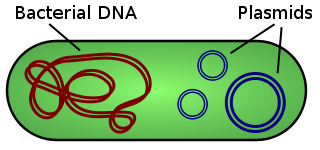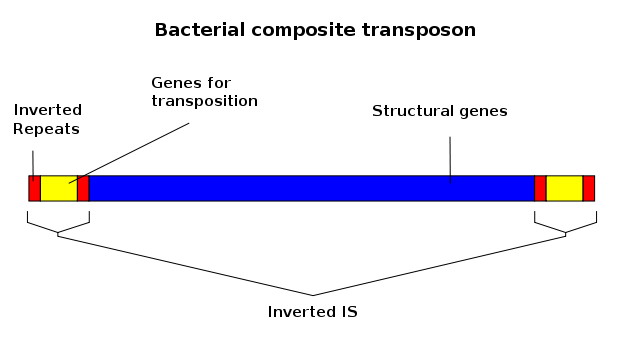Difference Between Plasmid and Transposon
Table of Contents
Key Difference – Plasmid vs Transposon
Bacteria contain chromosomal and non chromosomal DNA. Chromosomal DNA plays an important role in the growth of bacteria. Non chromosomal DNA does not encode essential genes for bacterial survival. A plasmid is a type of prokaryotic non chromosomal DNA. They are small, circular double stranded DNA which provides additional genetic advantages to bacteria. Transposon is a DNA sequence which can move to new positions within the genome. They are also known as mobile genetic material of bacteria. The key difference between plasmid and transposon is that plasmid is a non chromosomal DNA which replicates independently within the bacterium while transposon is a segment of chromosomal DNA which translocates within the genome of bacteria and changes the genetic sequence of the chromosome.
CONTENTS
1. Overview and Key Difference
2. What is Plasmid
3. What is Transposon
4. Side by Side Comparison – Plasmid vs Transposon
5. Summary
What is a Plasmid?
Plasmid is an extrachromosomal DNA of prokaryotes. It can replicate independently from the bacterial chromosome. One bacterium can have several plasmids inside. Plasmids are closed circular bits of DNA and they are small in size. Plasmid DNA bears a few genes which are not essential for the survival of bacterium. However, those genes in the plasmids provide additional genetic advantages to bacteria such as antibiotic resistance, herbicide resistance, heavy metal tolerance, etc. Special plasmids called F factor plasmids are involved in bacterial conjugation, which is a sexual method of reproduction.
Plasmids are used as vectors in recombinant DNA technology and gene cloning. Plasmids possess special features that make them suitable to be used as recombinant vectors in genetic engineering. They contain origin of replication, selectable marker genes, double stranded nature, small size and multiple cloning sites. Researchers can open plasmid DNA easily and the insert desired DNA fragments or genes into plasmids to make recombinant DNA. In addition, the transformation of recombinant plasmid into host bacterium is easier than the other vectors.

Figure 01: Plasmids
What is a Transposon?
A transposon is a fragment or sequence of DNA which can translocate within the bacterial genome. They are mobile DNA sequences. They move into new locations of the genome. These movements make changes in the sequence of the bacterial genome, causing significant changes in genetic information. They are the transposable genetic elements responsible for establishing new genetic sequences in bacteria. Transposons were first discovered by Barbara McClintock in the 1940s through experiments carried out with maize and she was awarded Nobel Prize for her work.
Transposons are sometimes referred to as jumping genes because these jumping sequences can block the transcription of genes and rearrange the genetic material of bacterium. They are also responsible for the movement of drug resistance, antibiotic resistance genes between plasmids and chromosomes.
There are two types of transposons based on the mechanism they use to move and insert. They are class I transposon (retrotransposons) and class II transposon (DNA transposons). Class I transposons use ‘copy and paste’ mechanism while class II transposons use ‘cut and paste mechanism’.
Transposon can move from a plasmid to chromosome or between two plasmids. Due to these movements, genes are mixed between bacterial species. Hence, transposons are used as vectors in genetic engineering to remove and integrate genetic sequences to organisms.

Figure 02: A bacterial DNA transposon
What is the difference between Plasmid and Transposon?
Plasmid vs Transposon | |
| Plasmid is a small circular double stranded non chromosomal DNA of bacteria. | Transposon is a segment of DNA which is able to move into new locations within the genome. |
| Self-Replication | |
| Plasmids are able to replicate independently from chromosomal DNA. | Transposons are unable to replicate independently. |
| Special Characteristics Encoded | |
| Plasmids provide several features such as antibiotic resistance and virulence. | Transposons do not encode for special traits. |
| Use as a Vector | |
| Plasmids are used as vectors in genetic engineering for making recombinant DNA. | Transposons are also used as vectors in genetic engineering for insertional mutagenesis. |
| Mutations and Changes in Sequence | |
| Plasmids are unable to cause significant mutations and alter genome sequence and size. | Transposition can create significant mutations and alter genome sequence and size. |
Summary – Plasmid vs Transposon
Plasmid is an extrachromosomal DNA commonly found in bacteria. It has the ability to replicate independently from bacterial chromosomal DNA. Plasmids contain genes which add genetic advantages to bacteria. However, plasmid DNA is not essential for the survival of bacteria. Transposons are mobile genetic elements which jump from one location to a new location within the genome. They are able to cause mutations and change the size and the sequence of genome. This is the difference between plasmid and transposon.
Reference:
1. Griffiths, Anthony JF. “Prokaryotic transposons.” An Introduction to Genetic Analysis. 7th edition. U.S. National Library of Medicine, 01 Jan. 1970. Web. 26 Apr. 2017
2. “Episomes, Plasmids, Insertion Sequences, and Transposons.” World of Microbiology and Immunology. Encyclopedia.com, n.d. Web. 27 Apr. 2017
Image Courtesy:
1. “Plasmid (english)”By User:Spaully on English wikipedia – Own work (CC BY-SA 2.5) via Commons Wikimedia
2. “Composite transposon” By Jacek FH – self-made, based on Image:Composite transposon.jpg (CC BY-SA 3.0) via Commons Wikimedia
ncG1vNJzZmivp6x7pbXFn5yrnZ6YsqOx07CcnqZemLyue8OinZ%2Bdopq7pLGMm5ytr5Wau268y5qqpqGUYq6vsIyvqmasopa7tLzOrKanZw%3D%3D